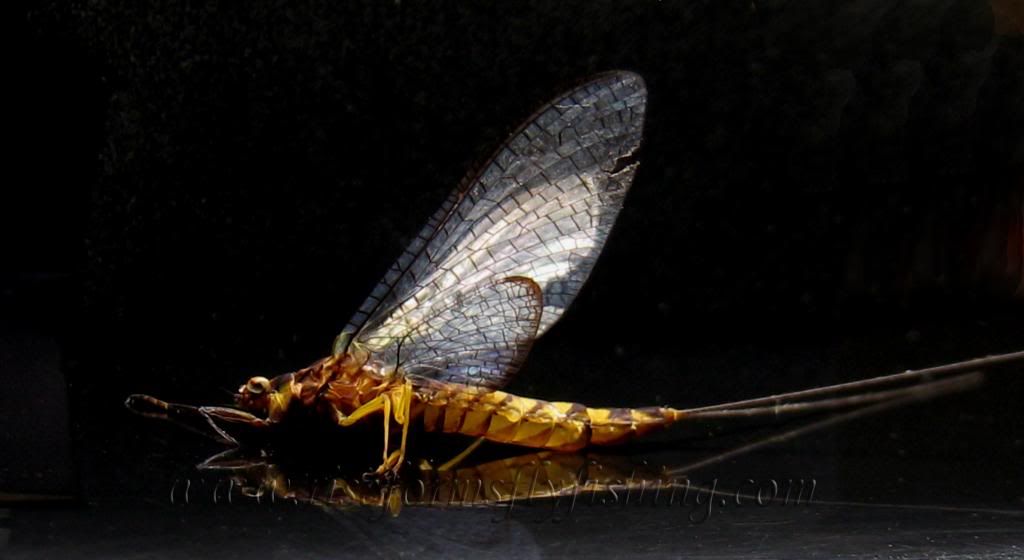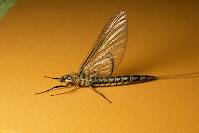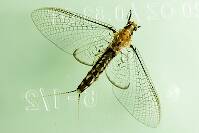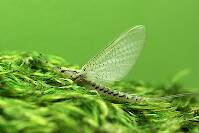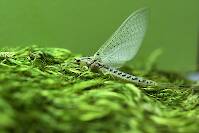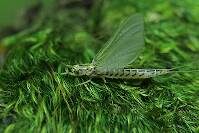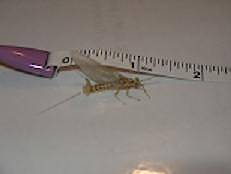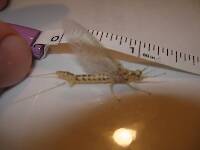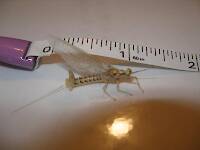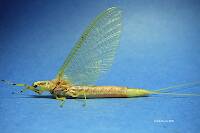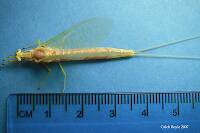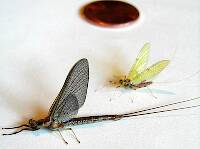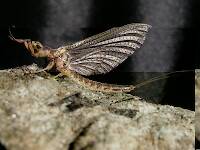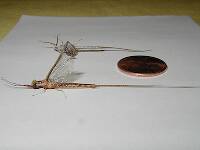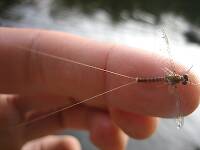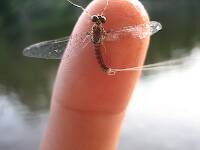
Salmonflies
Pteronarcys californica
The giant Salmonflies of the Western mountains are legendary for their proclivity to elicit consistent dry-fly action and ferocious strikes.
Featured on the forum

It's only barely visible in one of my pictures, but I confirmed under the microscope that this one has a prosternal horn and the antennae are mid-way between the eyes and front of the head capsule.
I'm calling this one Pycnopsyche, but it's a bit perplexing. It seems to key definitively to at least Couplet 8 of the Key to Genera of Limnephilidae Larvae. That narrows it down to three genera, and the case seems wrong for the other two. The case looks right for Pycnopsyche, and it fits one of the key characteristics: "Abdominal sternum II without chloride epithelium and abdominal segment IX with only single seta on each side of dorsal sclerite." However, the characteristic "metanotal sa1 sclerites not fused, although often contiguous" does not seem to fit well. Those sclerites sure look fused to me, although I can make out a thin groove in the touching halves in the anterior half under the microscope. Perhaps this is a regional variation.
The only species of Pycnopsyche documented in Washington state is Pycnopsyche guttifera, and the colors and markings around the head of this specimen seem to match very well a specimen of that species from Massachusetts on Bugguide. So I am placing it in that species for now.
Whatever species this is, I photographed another specimen of seemingly the same species from the same spot a couple months later.
I'm calling this one Pycnopsyche, but it's a bit perplexing. It seems to key definitively to at least Couplet 8 of the Key to Genera of Limnephilidae Larvae. That narrows it down to three genera, and the case seems wrong for the other two. The case looks right for Pycnopsyche, and it fits one of the key characteristics: "Abdominal sternum II without chloride epithelium and abdominal segment IX with only single seta on each side of dorsal sclerite." However, the characteristic "metanotal sa1 sclerites not fused, although often contiguous" does not seem to fit well. Those sclerites sure look fused to me, although I can make out a thin groove in the touching halves in the anterior half under the microscope. Perhaps this is a regional variation.
The only species of Pycnopsyche documented in Washington state is Pycnopsyche guttifera, and the colors and markings around the head of this specimen seem to match very well a specimen of that species from Massachusetts on Bugguide. So I am placing it in that species for now.
Whatever species this is, I photographed another specimen of seemingly the same species from the same spot a couple months later.

Troutnut is a project started in 2003 by salmonid ecologist Jason "Troutnut" Neuswanger to help anglers and
fly tyers unabashedly embrace the entomological side of the sport. Learn more about Troutnut or
support the project for an enhanced experience here.
Troutnut on Sep 12, 2013September 12th, 2013, 8:13 am EDT
Nice photo!
Jason Neuswanger, Ph.D.
Troutnut and salmonid ecologist
Troutnut and salmonid ecologist
Crepuscular on Sep 12, 2013September 12th, 2013, 2:23 pm EDT
Nice photo!
EDIT
Thanks. I'd call that H. atrocaudata but it seems too light. Any thoughts? Collected last Sunday. It's gotta be limbata right? But it's September. These streams are gonna drive me to drink...
Entoman on Sep 12, 2013September 12th, 2013, 11:10 pm EDT
Hi Eric,
You didn't mention its size, but assuming it's much smaller than the limbata drakes you see earlier in the Summer, I'd go with atrocaudata. You're right about it being too pale for most descriptions but there are more forms of the species in this genus than you can shake a stick at.:) A lot of them look pretty different and it wouldn't surprise me that atro could have a pale form.
From what I can make out, it seems to lack the two toned eyes of limbata and the way the abdominal maculation (ventral & dorsal) line up is pretty interesting. Looks almost ringed... Most (but not all) limbata specimens lack these types of ventral markings and even if they do have them, I don't remember them lining up this well. I believe this pattern may be more common with atro - at least the ones I've seen photographed.
You didn't mention its size, but assuming it's much smaller than the limbata drakes you see earlier in the Summer, I'd go with atrocaudata. You're right about it being too pale for most descriptions but there are more forms of the species in this genus than you can shake a stick at.:) A lot of them look pretty different and it wouldn't surprise me that atro could have a pale form.
From what I can make out, it seems to lack the two toned eyes of limbata and the way the abdominal maculation (ventral & dorsal) line up is pretty interesting. Looks almost ringed... Most (but not all) limbata specimens lack these types of ventral markings and even if they do have them, I don't remember them lining up this well. I believe this pattern may be more common with atro - at least the ones I've seen photographed.
"It's not that I find fishing so important, it's just that I find all other endeavors of Man equally unimportant... And not nearly as much fun!" Robert Traver, Anatomy of a Fisherman
Crepuscular on Sep 16, 2013September 16th, 2013, 6:10 am EDT
Thanks Kurt I showed this female to another person who is very familar with this mayfly and the stream where I collected it and he agrees with you and me (I guess that's what I said) that it's H. atrocaudata
Entoman on Sep 16, 2013September 16th, 2013, 12:38 pm EDT
Yeah, this genus drives me crazy more than any other. Well, many of the baetid genera are just as bad, I suppose.:) The problem is most of the characters formally used to field differentiate them haven't proved as helpful as once hoped. Body color & size, abdominal maculation, hatch timing, and banding along the outer edge of the hind wing are far from dependable for determining between the two. Entomologists have wrestled over even curated specimens! I guess I'm going by the eyes...
I've collected them from the end of May to as late as mid October, depending on location. They often look entirely different. Some are really big (40 mm range), some are half as big. Some are light, some are darker. Some have banded hind wings, some don't. Their tergal maculation is all over the map and none of them have been a really close match to any of the Spieth diagrams. Even so, I've been assured we only have limbata (prev. californica) out here, so my local critters don't cause ID frustration. The problem with your specimens is you live in Hex Central (too many species).:) As you mentioned, this particular specimen being female doesn't make it easier either!:)
BTW - have you ever seen these smaller pale Hexes this late before?
I've collected them from the end of May to as late as mid October, depending on location. They often look entirely different. Some are really big (40 mm range), some are half as big. Some are light, some are darker. Some have banded hind wings, some don't. Their tergal maculation is all over the map and none of them have been a really close match to any of the Spieth diagrams. Even so, I've been assured we only have limbata (prev. californica) out here, so my local critters don't cause ID frustration. The problem with your specimens is you live in Hex Central (too many species).:) As you mentioned, this particular specimen being female doesn't make it easier either!:)
BTW - have you ever seen these smaller pale Hexes this late before?
"It's not that I find fishing so important, it's just that I find all other endeavors of Man equally unimportant... And not nearly as much fun!" Robert Traver, Anatomy of a Fisherman
Lastchance on Sep 16, 2013September 16th, 2013, 3:10 pm EDT
Yep, it looks like a mayfly to me, too! You embarrass me with all that genius talk.
Crepuscular on Sep 16, 2013September 16th, 2013, 4:50 pm EDT
BTW - have you ever seen these smaller pale Hexes this late before?
Oh yeah. Every year at this time there are a lot of them. They usually start about the same time as the white fly. And last well into September. The males are darker ill try and get a decent photo of one of the boys.
Entoman on Sep 16, 2013September 16th, 2013, 11:28 pm EDT
Look forward to it. A good look at the privates should clear up any confusion... Hopefully! :)
Bruce - You're a piiece of work.
Bruce - You're a piiece of work.
"It's not that I find fishing so important, it's just that I find all other endeavors of Man equally unimportant... And not nearly as much fun!" Robert Traver, Anatomy of a Fisherman
Quick Reply
Related Discussions
Topic
Replies
Last Reply
Acroneuria specimen moved from genus to species level
In Acroneuria carolinensis Stonefly Nymph by Entoman
In Acroneuria carolinensis Stonefly Nymph by Entoman
0
Mar 11, 2012
by Entoman
by Entoman
10
Jun 30, 2009
by Jmd123
by Jmd123
69
Apr 1, 2012
by Pilonm
by Pilonm



